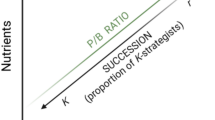Abstract—The total abundance of bacteria, the number of saprophytic, oligotrophic, and sulfate-reducing microorganisms, the shapes of bacterial cells, the primary and bacterial production, the destruction of organic matter, and the rate of sulfate reduction were studied in small Karelian lakes during the stagnation period. It has been shown that the uneven vertical distribution of light, temperature, oxygen, and hydrogen sulfide creates ecological niches for the development of many various groups of microorganisms. In most lakes, the minimum abundance of microorganisms was found in the surface water layer, while its maximum was in the near-bottom layers. The trophic status of a water body has a great influence on the formation and function of microbial communities. Autochthonic organic matter in the closed forest lakes under study (the local term is “lamba”) was formed due to phytoplankton photosynthesis, but bacterial production exceeded primary production in the hypolimnion of eutrophic lakes. The content of hydrogen sulfide, the abundance of sulfate-reducing bacteria, and the rate of sulfate reduction were maximal in the bottom sediments of eutrophic lambas.
Similar content being viewed by others
REFERENCES
Arinushkina, Y.V., Rukovodstvo po himicheskomu analizu pochv (Manual of Soil Chemical Analysis), Moscow: Mosk. Gos. Univ., 1961.
Bergey’s Manual of Systematic Bacteriology, 9th ed., Hoult, G., Krieg, N.R., Snit, P., Staley, J.T., and Williams, S., Eds., Moscow: Mir; 1997, vol. 2.
Dubinina, G.A., A study of the ecology of iron bacteria in fresh water bodies, Izv. Akad. Nauk SSSR, Ser. Biol., 1976, no. 4, pp. 575–592.
Fliermans, J.G., Schneider, C.P., and Schmidt, E.L., Direct measurement of bacterial stratification in Minnesota lakes, Arch. Hydrobiol., 1975, vol. 76, pp. 248–255.
Gibson, G.R., Physiology and ecology of the sulfate-reducing bacteria, J. Appl. Bacteriol., 1990, vol. 69, no. 6, pp. 769–797.
Gorlenko, V.M., Dubinina, G.A., and Kuznetsov, S.I., Ekologiya vodnykh mikroorganizmov (Ecology of Aquatic Microorganisms), Moscow: Nauka, 1977.
Hoch, M.E. and Kirchman, D.L., Seasonal and interannual variability in bacterial production and biomass in a temperate estuary, Mar. Ecol. Progr. Ser., 1993, vol. 98, pp. 283–295.
Jensen, L.M., Phytoplankton release of extracellular organic carbon, molecular weight composition, and bacterial assimilation, Mar. Ecol. Progr. Ser., 1983, vol. 11, pp. 39–48.
Kharkevich, N.S., Materials on small forest lakes (lambs) of Karelia, Tr. Karel. Fil. Akad. Nauk SSSR, 1960, vol. 27, pp. 70–133.
Kopylov, A.I. and Kosolapov, D.B., Bakterioplankton vodokhranilishch Verkhnei i Srednei Volgi (Bacterioplankton of the Upper and Middle Volga Reservoirs), Moscow: Sovrem. Guman. Univ., 2008.
Kuznetsov, S.I., Mikroflora ozer i ee geokhimicheskaya deyatel’nost’ (The Microflora of Lakes and its Geochemical Activity), Leningrad: Nauka, 1970.
Kuznetsov, S.I. and Dubinina, G.A., Metody izucheniya vodnykh mikroorganizmov (Methods of Studies in Aquatic Microorganisms), Moscow: Nauka, 1989.
Kuznetsov, S.I., Saralov, A.I., and Nazina, T.N., Mikrobiologicheskie protsessy krugovorota ugleroda i azota v ozerakh (Microbiological Processes of Carbon and Nitrogen Turnover in Lakes), Moscow: Nauka, 1985.
Lapteva, N.A., Electron microscopic study on the microflora of Rybinsk Reservoir, Mikrobiologiya, 1976, vol. 45, pp. 547–550.
Obernosterer, I. and Herndle, G.J., Phytoplankton extracellular release and bacterial growth: Dependence on the inorganic N:P ratio, Mar. Ecol. Progr. Ser., 1995, vol. 116, pp. 247–257.
Romanenko, V.I. and Kuznetsov, S.I., Ekologiya mikroorganizmov presnykh vodoemov (The Ecology of Microorganisms in Fresh Water Bodies), Leningrad: Nauka, 1974.
Romanenko, V.I., Rybakova, I.V., Sokolova, E.A., and Veresh, L., A variant of the diffusion method for determining free carbon dioxide, carbonates, and sulfides in water and bottom sediments in a closed bottle, Gidrobiol. Zh., 1990, vol. 26, no. 5, pp. 64–69.
Shiah, F.K. and Ducklow, H.W., Temperature regulation of heterotrophic bacterioplankton abundance, production, and specific growth in Chesapeake Bay, Limnol. Oceanogr., 1994, vol. 39, no. 6, pp. 1243–1258.
Sorokin, Yu.I., Primary production and microbiological processes in Lake Göygöl, Mikrobiologiya, 1968, vol. 37, no. 2, pp. 345–354.
Author information
Authors and Affiliations
Corresponding author
Ethics declarations
The authors declare that they have no conflict of interest. This article does not contain any studies involving animals or human participants performed by any of the authors.
Additional information
Translated by E. Makeeva
Rights and permissions
About this article
Cite this article
Lapteva, N.A., Sokolova, E.A. Vertical Distribution of Bacteria in Forest Lakes of Karelia. Biol Bull Russ Acad Sci 46, 1302–1307 (2019). https://doi.org/10.1134/S1062359019100194
Received:
Accepted:
Published:
Issue Date:
DOI: https://doi.org/10.1134/S1062359019100194




